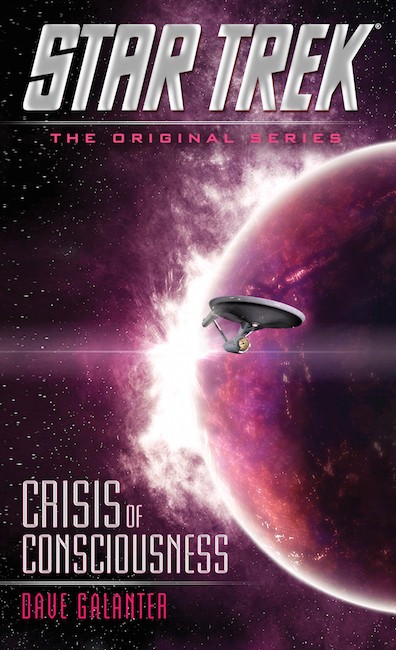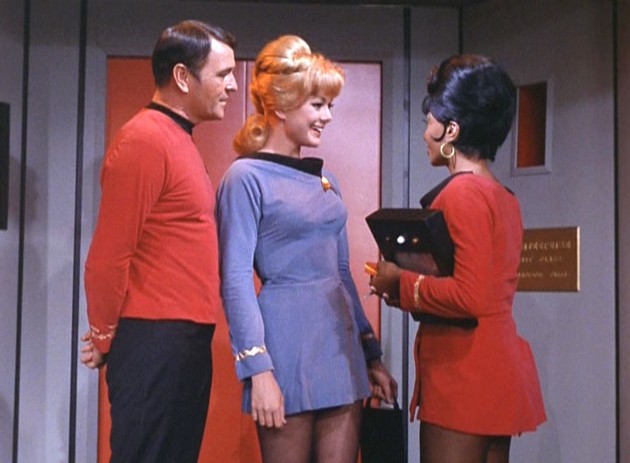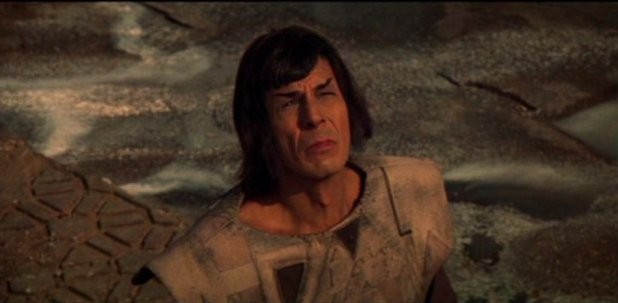“Star Trek: Crisis of Consciousness” Dave Galanter, Pocket Books 2015. (7 of 10)

Sometimes I just need a fix. Where there hasn’t been new “Star Trek” for some time now, and it will be next year before we get “Star Trek Beyond,” and 2017 before we get that new TV series we just heard about…I wanted to read something new. So I picked up “Crisis of Consciousness” by Dave Galanter. Set in the middle of the original USS Enterprise‘s five year mission, it gets the flavor of that era right–to the point that this feels like it could have been a missing episode from that series.
That doesn’t mean it’s perfect. The story has Captain Kirk and crew visiting Maabas, a planet long xenophobic, now suddenly interested in membership in the United Federation of Planets. Kirk is to investigate their petition, and ease their way into a pact with the Federation. As soon as the pact is signed, the Maabas are attacked by the Kenisians, who were the former inhabitants of that planet. The Kenisians abandoned Maabas thousands of years ago, leaving behind pieces of technology that now they want to reclaim.
The Kenisians are the more interesting of the two new races
The Maabas characters we meet are mostly uptight bureaucrats — not the kind of people that Captain Kirk suffers easily. This makes for some amusing moments, but also a challenge for Kirk to bring up to his level of courage/headstrongness/gambler’s bluffing. You know. Captain Kirkness. The Kenisians are the more interesting of the new races. Vulcanoid, they may have had a common ancestor with the Vulcans and Romulans, although not descended directly from Vulcans. Besides their pointy ears, they’ve got more in common with Vulcans, including limited telepathy. More interesting, they have the ability to transfer their consciousness into another Kenisian upon their death. Vulcans can do that to an extent, as Spock does to Dr. McCoy at the end of “Star Trek II: The Wrath of Khan.” We see that play out in “The Search for Spock,” as McCoy suffers through having another person live in his head. That same struggle is at play with some of the Kenisians, but instead of having two personalities inhabit their body, it’s dozens or more. It could also be compared to the Trill race on “Star Trek,” but instead of just being able to access the memories of another host body, it’s a continual conversation and (often) conflict. It makes negotiations with the Kenisians complicated, and their technology is more than a match for the Enterprise.
Galanter introduces some characters and ideas that connect us directly to other “Star Trek” episodes and even movies. Most notable is the character Carolyn Palamas. A lieutenant specializing in history, she proves to be a jack of all trades as she helps out during the shipboard crises resulting from battles with the Kenisians. She acts as a medic, setting Scotty’s arm, then as an engineer, helping him with some key repairs. During the process they grow closer together, and you can see the sparks of romance blooming between them. She’s the same Lieutenant Palamas in the classic Trek episode “Who Mourns for Adonais,” becoming the object of the godlike alien’s affections.

One of the things I love about current television series is seeing character and story arcs that play out across the course of a season. This story, inserted sometime before “Adonais,” gives me some of that.
Throughout the book, Galanter has Spock interacting with different characters, pushing his own consciousness in different directions. He’s separated from his friends on the Enterprise for most of the book, and between working with a Maabas ambassador and mind-melding with the Kenisian captain, is put on a path that will ultimately lead him to return to Vulcan and attempt the Vulcan kolinahr ritual, which would purge him of all emotion. This is where we see him in the opening scenes of “Star Trek: The Motion Picture,” and I appreciate seeing the seeds of where that may have come from.

In all, this was an entertaining premise and a good story. I liked where Galanter took the crew of the Enterprise, but it took a long time getting there. Some of the book seemed to be using a lot of words to not say very much. The idea of the Kenisians was interesting, but having every conversation with them turn into an internal committee meeting grew tedious quickly. That said, this felt more like an original series episode (often plodding and meandering themselves) than most other tie-in novels I’ve read. If you’re looking for a classic Trek fix, this could be what you’re looking for.